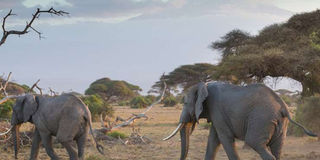Poaching slows but Africa's elephants still face extinction

The illegal slaughter of African elephants to feed Asia's demand for ivory has decreased by more than half in eight years. PHOTO | FILE | NATION MEDIA GROUP
What you need to know:
- On current trends, the African elephant is in danger of being "virtually wiped out", surviving only in small, heavily protected pockets, he said.
- A century ago up to 12 million of the world's heaviest land animal roamed the continent.
- Today, they number about 500,000, if forest elephants -- a sub-species -- are included.
The illegal slaughter of African elephants to feed Asia's demand for ivory has decreased by more than half in eight years, but the majestic mammals are still threatened with extinction, researchers warned Tuesday.
In 2011, poachers killed some 40,000 tuskers -- about ten percent of the continent's population, according to figures from the Convention on International Trade in Endangered Species (CITES), based in Geneva.
Last year the kill rate was about four per cent, or 15,000 animals, according to new research published in Nature Communications.
"We are seeing a downturn in poaching, but it is still above what we think is sustainable," co-author Colin Beale, a conservation biologist at the University of York, told AFP.
On current trends, the African elephant is in danger of being "virtually wiped out", surviving only in small, heavily protected pockets, he said.
A century ago up to 12 million of the world's heaviest land animal roamed the continent.
Today, they number about 500,000, if forest elephants -- a sub-species -- are included.
Despite a 1990 ban on international trade in ivory, demand in Southeast Asia and especially China has overwhelmed the capacity of local and global authorities to curb the carnage.
"Currently, poaching is worst in west and central Africa," said Beale.
"I worry most for the future of forest elephants."
Smaller, more solitary than their cousins on the savannah, forest tuskers in the Congo Basin are estimated to have declined by 65 percent over the last 15 years alone.
The countries in which poachers have been brought most to heel are Botswana, Namibia and South Africa.
Indeed, Botswana's elephant population has increased nearly ten-fold since 1970, according to co-author Julian Blanc, a researcher in the Wildlife Management Unit of the UN Environment Programme in Nairobi.
GOOD MANAGEMENT
"Due to good management, the country was largely unaffected by poaching in the 1980s, as well as the current episode that began in the mid-2000s," he told AFP.
But the researchers emphasised that law enforcement alone cannot solve the problem.
"We need to reduce the demand in Asia and improve the livelihoods of people who are living with elephants in Africa," said Beale.
To better understand the complex link between ivory and poaching, the researchers looked at data from a CITES programme that records the sighting of elephant carcasses by park rangers across 53 protected sites in Africa.
Changes in the level of illegal killing tracked closely to fluctuating prices in Asia for ivory.
The prevalence of poaching also matched key indicators of corruption and poverty, which varied sharply across regions.
Ultimately, however, the biggest threat to Loxodonta africana may not be human greed but our ever-expanding footprint.
"Habitat destruction and fragmentation caused by humans may be the more serious threat to elephant survival in the long term," said Blanc.
West Africa -- which today has, by far, the smallest elephant population -- is also the region in which the most habitat has been lost to agriculture and urbanisation, he pointed out.
It is unclear whether a 2017 ban on the sale of ivory in China has dampened demand or simply shifted the once-legal trade underground, the researchers said.
"We have no good evidence yet that the ban and associated demand reduction campaigns are working," said Beale. "So I have concerns that the current decline may be temporary."
An investigation by the wildlife trade monitoring network TRAFFIC found that even though legally licensed stores it had visited in 2017 no longer sold ivory the following year, the total amount of illegal ivory pieces found had actually increased.
L. africana is listed as "vulnerable" on the International Union for the Conservation of Nature (IUCN) Red List of endangered species.





